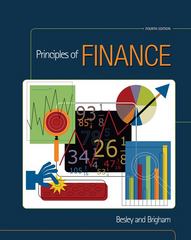Question
Stephen Quance, president of Amtek Ironworks, is faced with a classic problem in capital budgeting: whether or not to buy a new machine to replace
Stephen Quance, president of Amtek Ironworks, is faced with a classic problem in capital budgeting: whether or not to buy a new machine to replace existing equipment. Amtek Ironworks makes iron castings for manufacturing use. The Spartan Machine Molder would replace several older stamping machines and would improve quality and increase capacity for expansion. Quance, at the request of the board of directors, is to conduct a careful analysis of the replacement proposal and recommend an investment decision to the board.
Sand molds used to make iron castings are currently created in a semi-automated process. This process is highly labor-intensive and requires continued investment in a highly-skilled labor force. The Spartan Machine Molder would replace six of these semi-automated machines that, together, had originally cost $831,614 four years ago. All machines at Amtek are depreciated using a 10-year accelerated depreciation schedule dictated by the IRS (see table at end of case). Quance believes that these six machines would last for the next 8 years with regular maintenance, but would be worthless after that. Quance also knows that he can sell these machines today for $260,000.
The existing six machines require 12 workers per shift[1] currently earning $14.66 per hour per worker. In addition, these machines require a total of 3 maintenance workers at $15.70 per hour per worker as well as annual maintenance costs of $8,000. During the past year, these machines consumed $24,600 in electrical power.
The purchase price of the Spartan Machine Molder is $1,700,000. The cost for modifying the existing plant for the new machine is $310,000. Allowing for all installation and testing costs, the final total cost to Amtek would be $2.02 million, all of which would be capitalized and depreciated to zero over ten years using the accelerated depreciation schedule. However, due to the high anticipated usage of this machine, Quance believes that the new machine would need to be replaced in 8 years and would have no salvage value at that time.
The new machine would require only one worker per shift, earning $22.72 per hour, and they would use contract maintenance for $119,000 per year. The new machine would use $53,700 in electrical power during its first year, but would save the company at least $10,400 annually through efficiency gains in other areas of the plant.
With the current six machines, space requirements for raw materials and inventory for each machine occupy 30% of the total plant floor space. With the new machine, half of this space would be freed up for other purposes (although presently there is no need for new space.)
Given the firms collective bargaining agreement with the plants labor union, Quance was unsure if he would be able to lay off the operators of the existing equipment. Thus, the extent of labor savings would depend on negotiations with the labor union. Also, the Spartan Machine Molder would result in higher quality products than currently being produced. Given the current competitive environment, this outcome was important but unquantifiable. Also, the Spartan Machine Molder had a 30% higher maximum capacity than the six existing machines, but those machines were currently running at 90% capacity and Quance was unsure about when additional capacity would be needed (especially given the current economic situation).
Quance believes that general inflation will be 4% per year, but that wage costs will only increase by 3% per year for the foreseeable future. The corporate tax rate is 35%, and Amtek expects sizeable taxable income in all upcoming years. For capital expenditures such as this one, Amtek employs a cost of capital of 10%.
Any costs associated with purchasing and installing the equipment would be incurred immediately, while operating costs would be recognized starting next year.
Your group has been hired by Mr. Quance to analyze the issues facing Amteks purchase decision. You should address the following tasks and questions for Mr. Quance. You should attach tables and spreadsheets to support your analysis. This project is due Tuesday, October 4th, at the beginning of class.
- (30 pts) Should Amtek purchase the new Spartan Machine Molder? Justify your recommendation with valuations.
- (15 pts) Are there issues left unresolved in the analysis thus far? What additional considerations should be made and what kind of information would you like to have?
- (15 pts) What are the different risks involved in purchasing the Spartan Machine Molder vs. staying with the semi-automated machines?
10-year Accelerated Depreciation Schedule
| Year: | 0 | 1 | 2 | 3 | 4 | 5 | 6 | 7 | 8 | 9 | 10 |
| % depreciated | 10.0 | 18.0 | 14.4 | 11.52 | 9.22 | 7.37 | 6.55 | 6.55 | 6.55 | 6.55 | 3.29 |
[1] Amtek operated two 8-hour shifts per day. Given holidays and weekends, Amtek operated a total of 210 days per year.
Step by Step Solution
There are 3 Steps involved in it
Step: 1

Get Instant Access to Expert-Tailored Solutions
See step-by-step solutions with expert insights and AI powered tools for academic success
Step: 2

Step: 3

Ace Your Homework with AI
Get the answers you need in no time with our AI-driven, step-by-step assistance
Get Started


